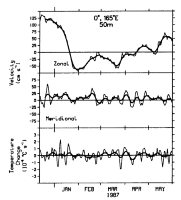
U.S. Dept. of Commerce / NOAA / OAR / PMEL / Publications
Another possible candidate contributing to variations in SST and heat content is lateral advection. A 50-m velocity record is the shallowest time series we have in 1987 to test this hypothesis. However, as discussed by McPhaden et al. [1990], daily averaged 10- and 50-m currents are highly correlated (0.87 for 164 days of overlapping 1986 data), so that fluctuations at 50 m can be used as an index of flow in the surface layer.
Fig. 14. Zonal velocity (u), meridional velocity (v), and
time rate of change of temperature ( T/
T/ T)
at 50 m from December 13, 1986, to May 31, 1987, at 0°, 165°E. Daily averaged
data are shown by thin curves and 15-day Hanning filtered data are shown by
thick curves.
T)
at 50 m from December 13, 1986, to May 31, 1987, at 0°, 165°E. Daily averaged
data are shown by thin curves and 15-day Hanning filtered data are shown by
thick curves.
Velocity at 50 m is shown in Figure 14 for that
time period when the 50-m depth is located in the surface layer (see Figure
3). Flow in the zonal direction is strongly eastward at speeds greater than
100 cm s in December 1986, westward at speeds
up to 70 cm s
in December 1986, westward at speeds
up to 70 cm s from late January to early
April 1987, then eastward again beginning in mid-April. The range of zonal speeds
in these month-to-month measurements is about 200 cm s
from late January to early
April 1987, then eastward again beginning in mid-April. The range of zonal speeds
in these month-to-month measurements is about 200 cm s .
Meridional velocities vary at periods near 10 days with peak-to-peak amplitudes
of 50-100 cm s
.
Meridional velocities vary at periods near 10 days with peak-to-peak amplitudes
of 50-100 cm s ; these fluctuations are
associated with the second temperature EOF (Figure
5b) and are related to mixed Rossby-gravity wave dynamics [Hayes
et al., 1988]. Velocity variations in both directions are in part forced
by local winds, as discussed by McPhaden
et al. [1990] and Hayes
et al. [1988].
; these fluctuations are
associated with the second temperature EOF (Figure
5b) and are related to mixed Rossby-gravity wave dynamics [Hayes
et al., 1988]. Velocity variations in both directions are in part forced
by local winds, as discussed by McPhaden
et al. [1990] and Hayes
et al. [1988].
Figure 14 also shows the centered difference
equivalent of  T/
T/ t,
variations of which would be highly correlated with one or both of the velocity
components if lateral advection were dominant in the temperature balance. In
addition, according to (6), one would be able to
estimate the time-averaged horizontal temperature gradient by regressing velocity
against
t,
variations of which would be highly correlated with one or both of the velocity
components if lateral advection were dominant in the temperature balance. In
addition, according to (6), one would be able to
estimate the time-averaged horizontal temperature gradient by regressing velocity
against  T/
T/ t.
However, cross correlations of daily averaged zonal velocity (u) and
meridional velocity (v) with
t.
However, cross correlations of daily averaged zonal velocity (u) and
meridional velocity (v) with  T/
T/ t
are only 0.05 and 0.17, respectively, neither of which exceeds the 95% confidence
limits for the null hypothesis of 0.11 in the zonal direction and 0.26 in the
meridional direction. We repeated these calculations for data smoothed with
a 15-day Hanning filter (approximately equivalent to computing weekly averages).
As shown in Figure 14, there are times such as
early March to mid-April when the low-pass
t
are only 0.05 and 0.17, respectively, neither of which exceeds the 95% confidence
limits for the null hypothesis of 0.11 in the zonal direction and 0.26 in the
meridional direction. We repeated these calculations for data smoothed with
a 15-day Hanning filter (approximately equivalent to computing weekly averages).
As shown in Figure 14, there are times such as
early March to mid-April when the low-pass  T/
T/ t
and meridional velocity track reasonably closely. Overall however, the cross
correlations for the 15-day Hanning (u,
t
and meridional velocity track reasonably closely. Overall however, the cross
correlations for the 15-day Hanning (u,  T/
T/ t)
and (v,
t)
and (v,  T/
T/ t)
data are 0.14 and 0.23, neither of which exceeds the 95% confidence limits of
0.34 and 0.38 for the low-pass time series. We repeated these calculations for
t)
data are 0.14 and 0.23, neither of which exceeds the 95% confidence limits of
0.34 and 0.38 for the low-pass time series. We repeated these calculations for
 T/
T/ t computed
from SST and from temperature averaged over 0-10 m and 0-75 m, assuming that
the 50-m currents were representative of depth-averaged flow in the surface
layer. No clear pattern of significant cross correlation emerged, implying that,
in general, lateral advection has a negligible effect on surface layer temperature
variability on daily to monthly time scales for the period of this study. This
is consistent with a mean temperature field characterized by weak horizontal
gradients in the vicinity of 0°, 165°E during much of 1987 (for example, Figure
1).
t computed
from SST and from temperature averaged over 0-10 m and 0-75 m, assuming that
the 50-m currents were representative of depth-averaged flow in the surface
layer. No clear pattern of significant cross correlation emerged, implying that,
in general, lateral advection has a negligible effect on surface layer temperature
variability on daily to monthly time scales for the period of this study. This
is consistent with a mean temperature field characterized by weak horizontal
gradients in the vicinity of 0°, 165°E during much of 1987 (for example, Figure
1).
Go to previous or next section
Return to Abstract